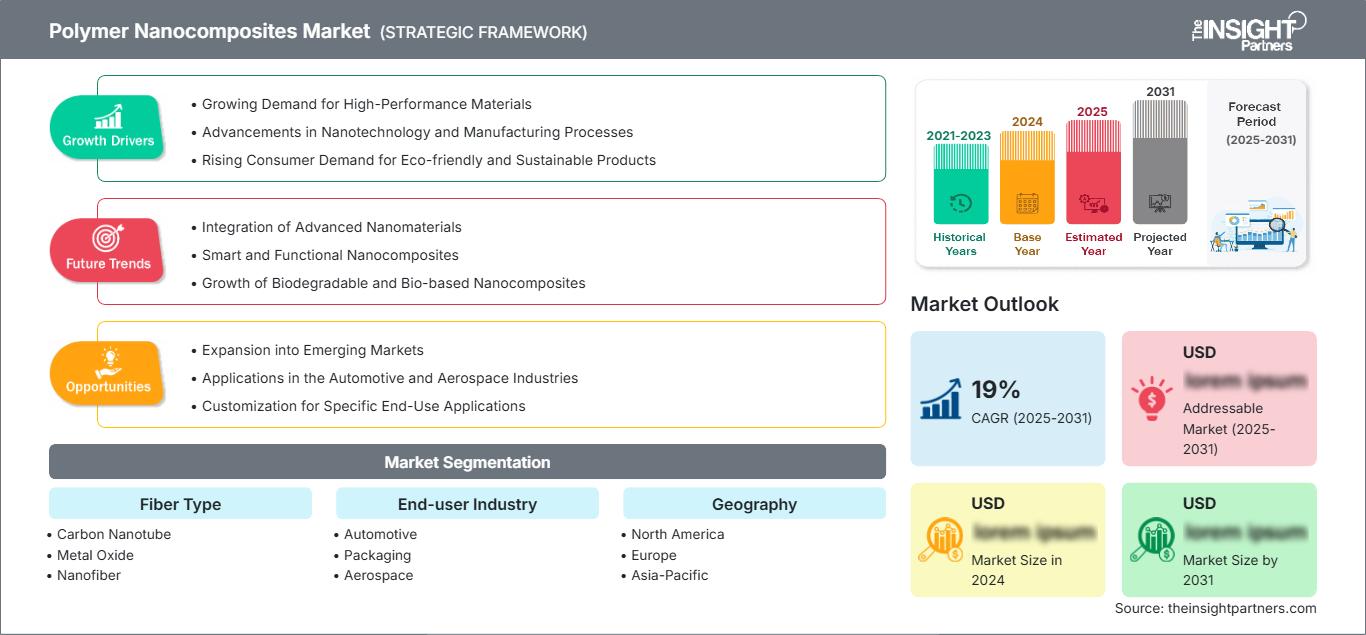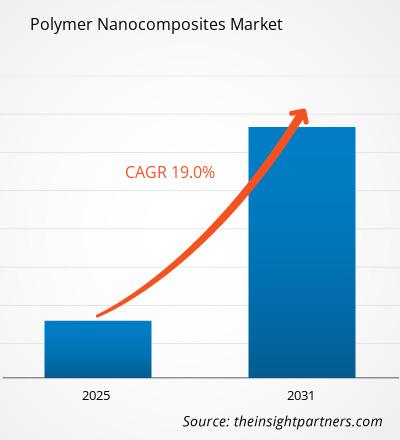ポリマーナノ複合材料市場は、2025年から2031年にかけて年平均成長率(CAGR)19%で成長し、市場規模は2024年のXX百万米ドルから2031年にはXX百万米ドルに拡大すると予想されています。
ポリマーナノ複合材料市場は、繊維タイプ(カーボンナノチューブ、金属酸化物、ナノファイバー、ナノクレイ、その他)、エンドユーザー産業(自動車、包装、航空宇宙、防衛、エレクトロニクス、エネルギー、その他)、および地域(北米、ヨーロッパ、アジア太平洋、中東およびアフリカ、中南米)別に分析されています。ポリマーナノ複合材料は、ポリマーマトリックスと少量のナノ粒子で構成される複合材料です。これらのナノ粒子は、粘土、炭素、金属酸化物などのさまざまな材料から作られ、ポリマーマトリックスの特性を向上させるために使用されます。ポリマーナノ複合材料市場は、自動車、エレクトロニクス、パッケージングなど、さまざまな業界における軽量で高性能な材料の需要の高まりによって牽引されています。
レポートの目的
The Insight Partners によるレポート「ポリマーナノ複合材料市場」は、現在の状況と将来の成長、主な推進要因、課題、機会について説明することを目的としています。これにより、次のようなさまざまなビジネス関係者に洞察が提供されます。
- 技術プロバイダー/メーカー: 進化する市場動向を理解し、潜在的な成長機会を把握することで、情報に基づいた戦略的意思決定を行うことができます。
- 投資家: 市場の成長率、市場の財務予測、バリューチェーン全体に存在する機会に関する包括的なトレンド分析を実施します。
- 規制機関: 市場の乱用を最小限に抑え、投資家の信頼と信用を維持し、市場の健全性と安定性を維持することを目的として、市場における政策と警察活動を規制します。
ポリマーナノ複合材料市場のセグメンテーション:繊維タイプ
- カーボンナノチューブ
- 金属酸化物
- ナノファイバー
- ナノクレイ
エンドユーザー産業
- 自動車
- 包装
- 航空宇宙
- 防衛
- エレクトロニクス
- エネルギー
レポートの一部、国レベルの分析、Excelデータパックなどを含め、スタートアップ&大学向けに特別オファーや割引もご利用いただけます(無償)
ポリマーナノ複合材料市場: 戦略的洞察

- このレポートの主要な市場動向を入手してください。この無料サンプルには、市場動向から見積もりや予測に至るまでのデータ分析が含まれます。
ポリマーナノ複合材料市場の成長要因
- 高性能材料の需要増加:世界のポリマーナノ複合材料市場を牽引する主な要因の一つは、様々な業界における高性能材料の需要増加です。ナノクレイ、カーボンナノチューブ、グラフェンなどのナノ材料をポリマーマトリックスに組み込むことで作られるポリマーナノ複合材料は、優れた機械的強度、熱安定性、導電性、バリア性などの特性を備えています。これらの独自の特性により、ポリマーナノ複合材料は自動車、航空宇宙、電子機器、包装などの業界で非常に求められています。企業が製品の性能と耐久性の向上を目指す中で、ポリマーナノ複合材料の需要は増加しており、市場の成長を牽引しています。
- ナノテクノロジーと製造プロセスの進歩:ナノテクノロジーと製造プロセスの継続的な進歩も、ポリマーナノ複合材料市場の成長を牽引しています。分散技術の向上とナノ材料のポリマーマトリックスへの統合に対するより優れた制御により、メーカーはより一貫した特性を持つナノ複合材料を製造できるようになり、より幅広い用途に適したものになります。さらに、ナノ材料の製造コストが低下し、生産規模を拡大する能力が向上するにつれて、ポリマーナノ複合材料はより手頃な価格になり、さまざまな業界で利用しやすくなり、市場の成長をさらに促進します。
- 環境に優しく持続可能な製品に対する消費者の需要の高まり:もう一つの重要な推進力は、環境に優しく持続可能な材料に対する需要の高まりです。ポリマーナノ複合材料は、材料の使用量を削減し、製品寿命を延ばし、環境への影響を最小限に抑える可能性があるため、従来の材料に代わる魅力的な選択肢と見なされています。たとえば、包装業界では、ポリマーナノ複合材料を使用することで、より薄く、より強く、より効率的な包装ソリューションを実現し、原材料とエネルギーの消費を削減できます。世界中の産業界が持続可能な慣行の導入を求める圧力が高まる中、環境に優しいポリマーナノ複合材料の需要は増加傾向にあります。
ポリマーナノ複合材料市場の将来動向
- 先進ナノ材料の統合:ポリマーナノ複合材料市場における今後の重要な動向の一つは、グラフェン、カーボンナノチューブ、その他の2Dナノ材料などの先進ナノ材料の統合です。これらのナノ材料は、高い導電性、機械的強度、熱安定性など、優れた特性を持つことで知られており、ポリマー複合材料への応用に非常に魅力的です。研究が進むにつれて、さらに高度な特性を持つ新しいナノ材料が探索され、ポリマーナノ複合材料の潜在的な用途が拡大しています。今後の市場では、ポリマーナノ複合材料の機能性と性能を向上させる高度なナノ材料の開発に重点が置かれると予想されます。
- スマートで機能的なナノ複合材料:スマートで機能的なナノ複合材料の開発は、ポリマーナノ複合材料市場における有望なトレンドです。スマートナノ複合材料は、温度、圧力、光、電場などの外部刺激に反応するように設計されており、自己修復材料、センサー、アクチュエーターなど、さまざまな用途に使用できます。強化されたセンシング機能や適応性など、特定の機能を備えた革新的な材料に対する需要の高まりが、このトレンドの成長を牽引しています。ヘルスケア、エレクトロニクス、自動車などの業界がより汎用性と応答性に優れた材料を求めているため、スマートポリマーナノ複合材料の市場は拡大し続けるでしょう。
- 生分解性およびバイオベースナノ複合材料の成長:持続可能性への注目が、生分解性およびバイオベースのポリマーナノ複合材料の開発につながっています。再生可能で生分解性のポリマーから作られるこれらのナノ複合材料は、環境への影響が少なく、従来の石油由来の材料に代わる可能性を秘めていることから、注目を集めています。プラスチック汚染対策と化石燃料への依存軽減に向けた世界的な取り組みが強化されるにつれ、生分解性ポリマーナノ複合材料は、包装、農業、消費財などの業界でますます人気が高まっています。こうした製品の需要は今後も高まり、バイオベースナノ複合材料の革新が市場を牽引するでしょう。
ポリマーナノ複合材料の市場機会
- 新興市場への進出:特にアジア太平洋、ラテンアメリカ、アフリカといった新興市場は、世界のポリマーナノ複合材料市場にとって大きなチャンスとなっています。これらの地域では、急速な工業化、都市化、そして自動車、エレクトロニクス、建設などの分野の成長が見られ、優れた性能と持続可能性を備えた先進材料の需要が高まっています。これらの地域におけるポリマーナノ複合材料の採用拡大は、企業が市場シェアを拡大し、急成長するインフラ整備と工業化の潮流を活かすのに役立ちます。さらに、新興経済国における環境問題への意識の高まりは、環境に優しいポリマーナノ複合材料の需要を促進するでしょう。
- 自動車および航空宇宙産業における用途:自動車および航空宇宙産業は、ポリマーナノ複合材料市場にとって大きなビジネスチャンスです。自動車製造において、ポリマーナノ複合材料は車両の軽量化、燃費向上、部品の総合的な性能向上に利用されています。同様に、航空宇宙産業においても、これらの材料は高性能部品にとって極めて重要な強度対重量比の向上を実現します。両業界とも軽量、燃費効率に優れ、高性能な材料の開発に注力し続けているため、これらの分野におけるポリマーナノ複合材料の需要は急速に増加すると予想されます。
- 特定の最終用途向けカスタマイズ:ポリマーナノ複合材料市場における最も有望なビジネスチャンスの一つは、特定の最終用途向け材料のカスタマイズにあります。ヘルスケア、包装、エレクトロニクス、建設など、様々な業界では、熱安定性、導電性、機械的強度といった材料特性に対する独自の要件があります。ポリマーナノ複合材料メーカーは、様々な業界の固有のニーズを満たすカスタマイズされたソリューションを提供することで、こうした需要を活かすことができます。特定の用途に合わせてポリマーナノ複合材料をカスタマイズできる能力は、新たな収益源を開拓し、企業が専門性の高い製品でニッチ市場をターゲットにすることを可能にします。
ポリマーナノ複合材料市場の地域別分析
予測期間を通じてポリマーナノ複合材料市場に影響を与える地域的な動向と要因については、The Insight Partnersのアナリストが詳細に解説しています。このセクションでは、北米、ヨーロッパ、アジア太平洋、中東・アフリカ、中南米におけるポリマーナノ複合材料市場のセグメントと地域についても解説しています。
ポリマーナノ複合材料市場レポートの範囲
| レポート属性 | 詳細 |
|---|---|
| の市場規模 2024 | US$ XX million |
| 市場規模別 2031 | US$ XX Million |
| 世界的なCAGR (2025 - 2031) | 19% |
| 過去データ | 2021-2023 |
| 予測期間 | 2025-2031 |
| 対象セグメント |
By 繊維の種類
|
| 対象地域と国 | 北米
|
| 市場リーダーと主要企業の概要 |
|
ポリマーナノ複合材料市場のプレーヤーの密度:ビジネスダイナミクスへの影響を理解する
ポリマーナノコンポジット市場は、消費者の嗜好の変化、技術の進歩、製品の利点に対する認知度の高まりといった要因によるエンドユーザーの需要増加に牽引され、急速に成長しています。需要の増加に伴い、企業は製品ラインナップの拡充、消費者ニーズへの対応のためのイノベーション、そして新たなトレンドの活用を進めており、これが市場の成長をさらに加速させています。

- 入手 ポリマーナノ複合材料市場 主要プレーヤーの概要
主なセールスポイント
- 包括的な調査範囲:本レポートは、ポリマーナノ複合材料市場における製品、サービス、種類、エンドユーザーの分析を包括的に網羅し、包括的な展望を提供しています。
- 専門家による分析:本レポートは、業界の専門家とアナリストの深い理解に基づいて作成されています。
- 最新情報:本レポートは、最新の情報とデータ動向を網羅しているため、ビジネスの関連性を保証します。
- カスタマイズオプション:本レポートは、特定のクライアントの要件に対応し、ビジネス戦略に適切に適合するようにカスタマイズできます。
したがって、ポリマーナノ複合材料市場に関する調査レポートは、業界のシナリオと成長見通しを解読し理解するための先導役となります。いくつかの妥当な懸念事項があるかもしれませんが、本レポートの全体的なメリットは、デメリットを上回る傾向があります。
- 過去2年間の分析、基準年、CAGRによる予測(7年間)
- PEST分析とSWOT分析
- 市場規模価値/数量 - 世界、地域、国
- 業界と競争環境
- Excel データセット
最新レポート
関連レポート
お客様の声
購入理由
- 情報に基づいた意思決定
- 市場動向の理解
- 競合分析
- 顧客インサイト
- 市場予測
- リスク軽減
- 戦略計画
- 投資の正当性
- 新興市場の特定
- マーケティング戦略の強化
- 業務効率の向上
- 規制動向への対応




















 無料サンプルを入手 - ポリマーナノ複合材料市場
無料サンプルを入手 - ポリマーナノ複合材料市場